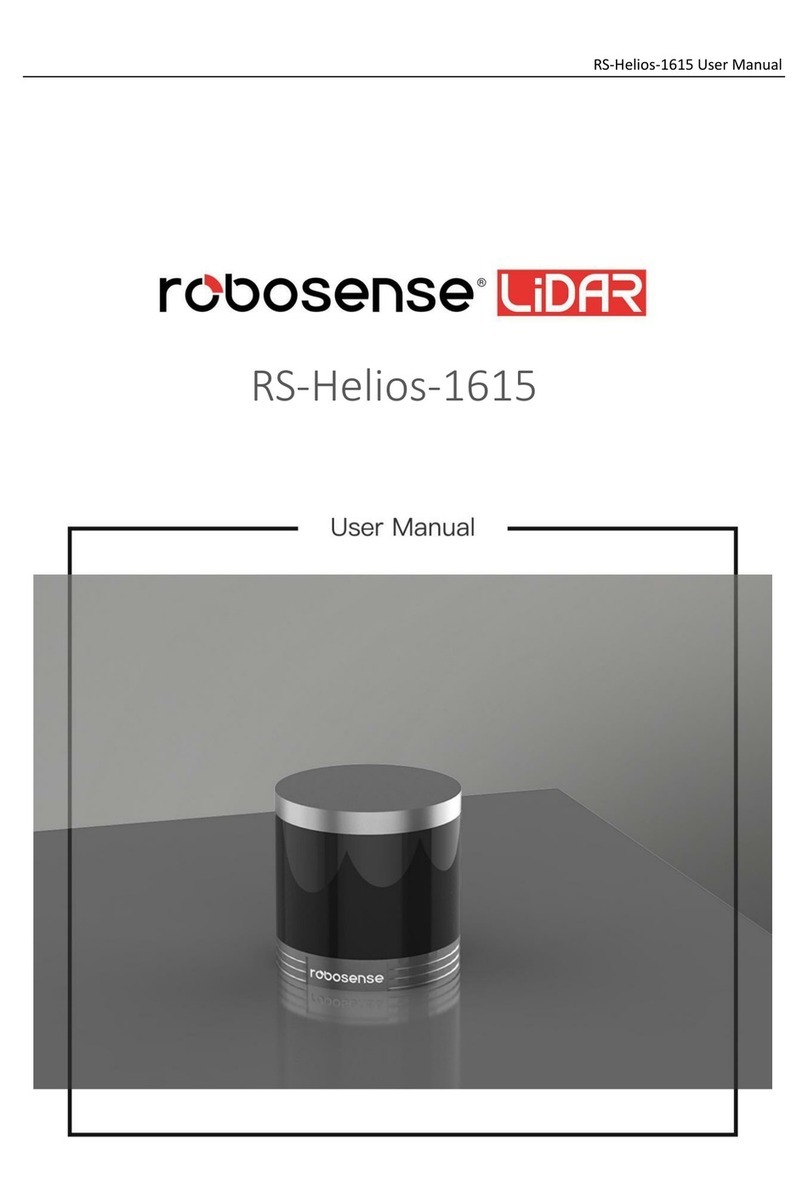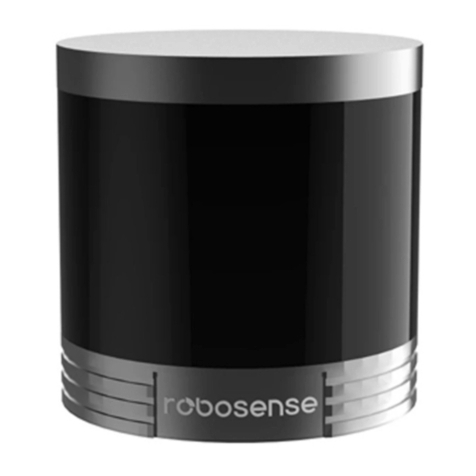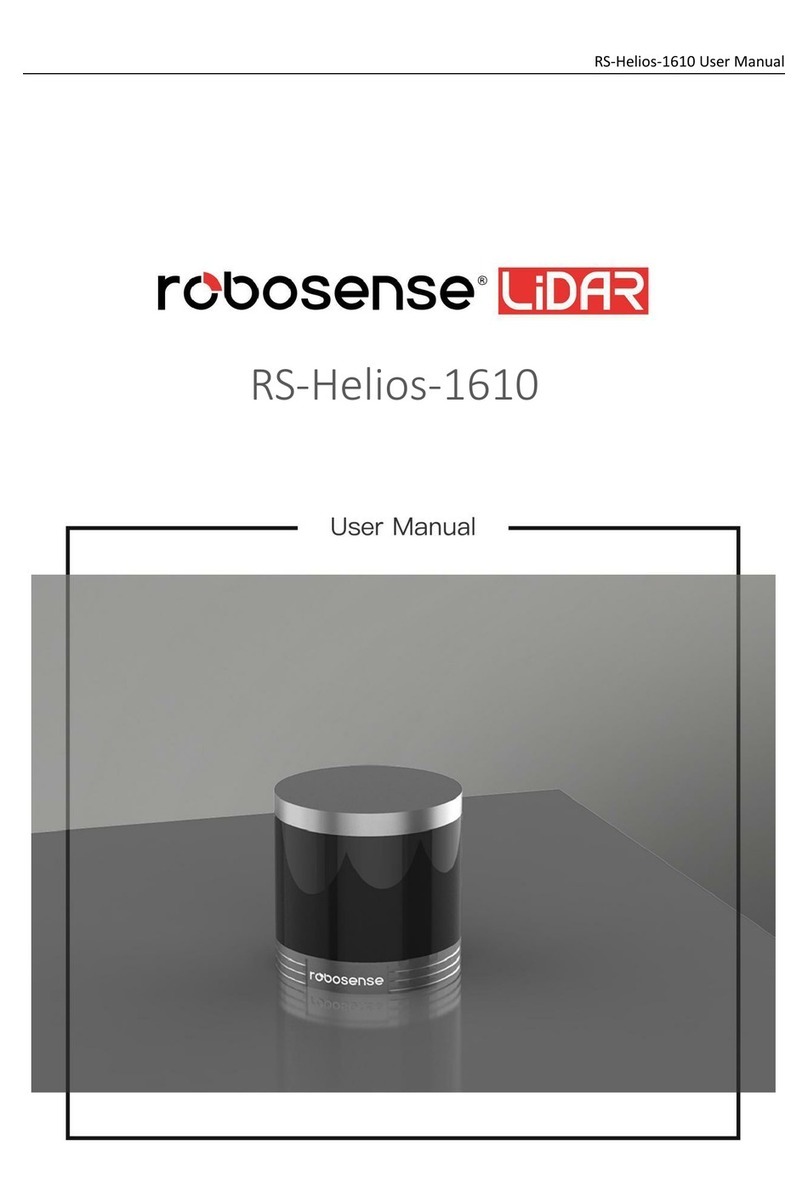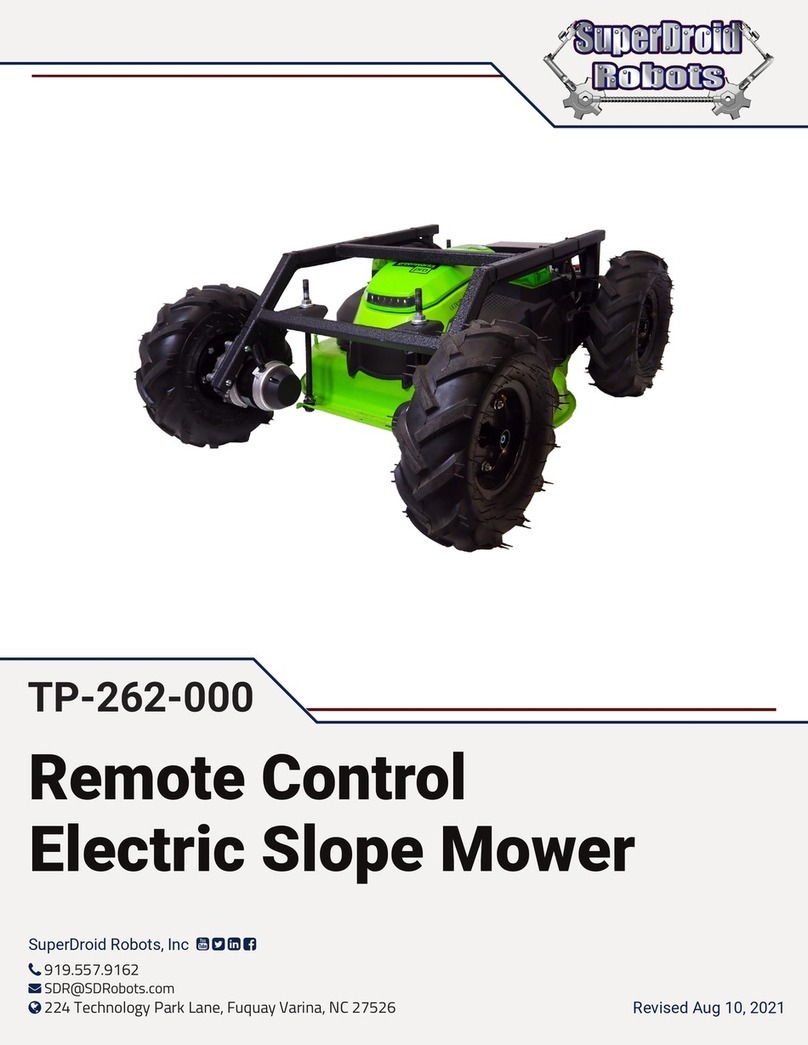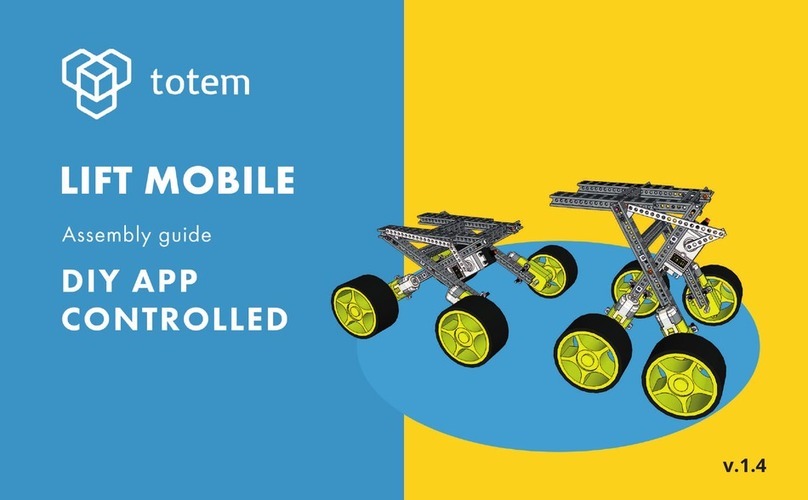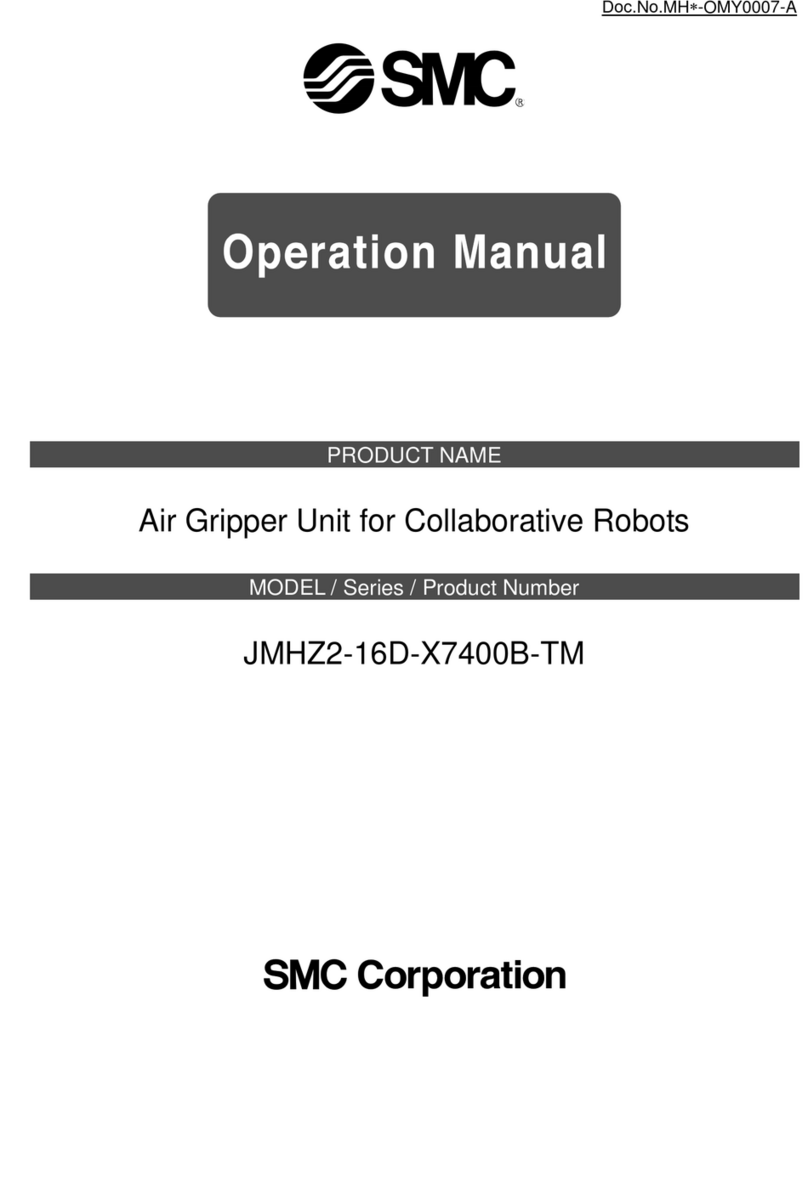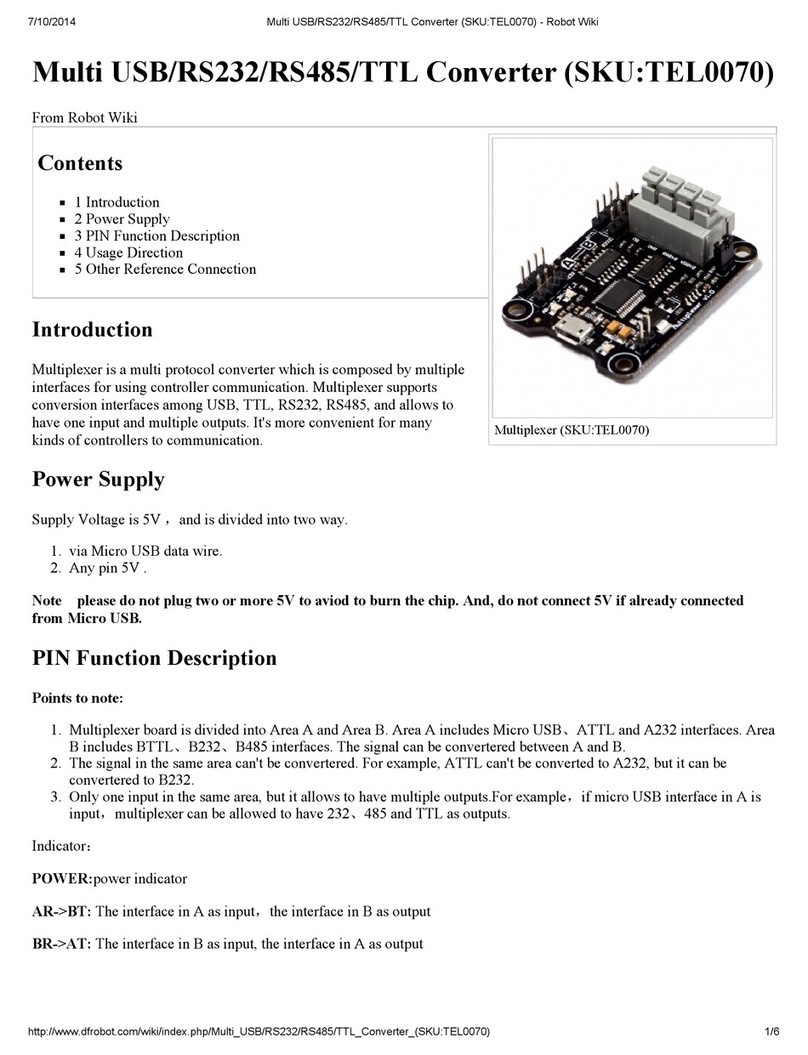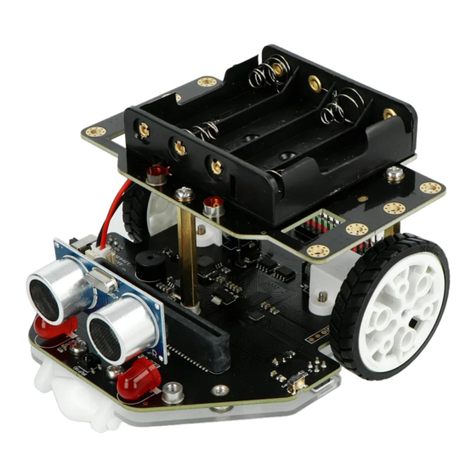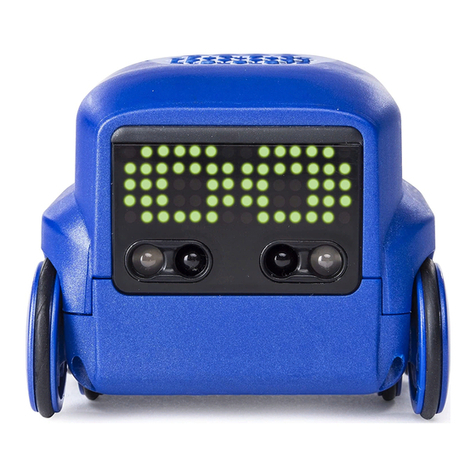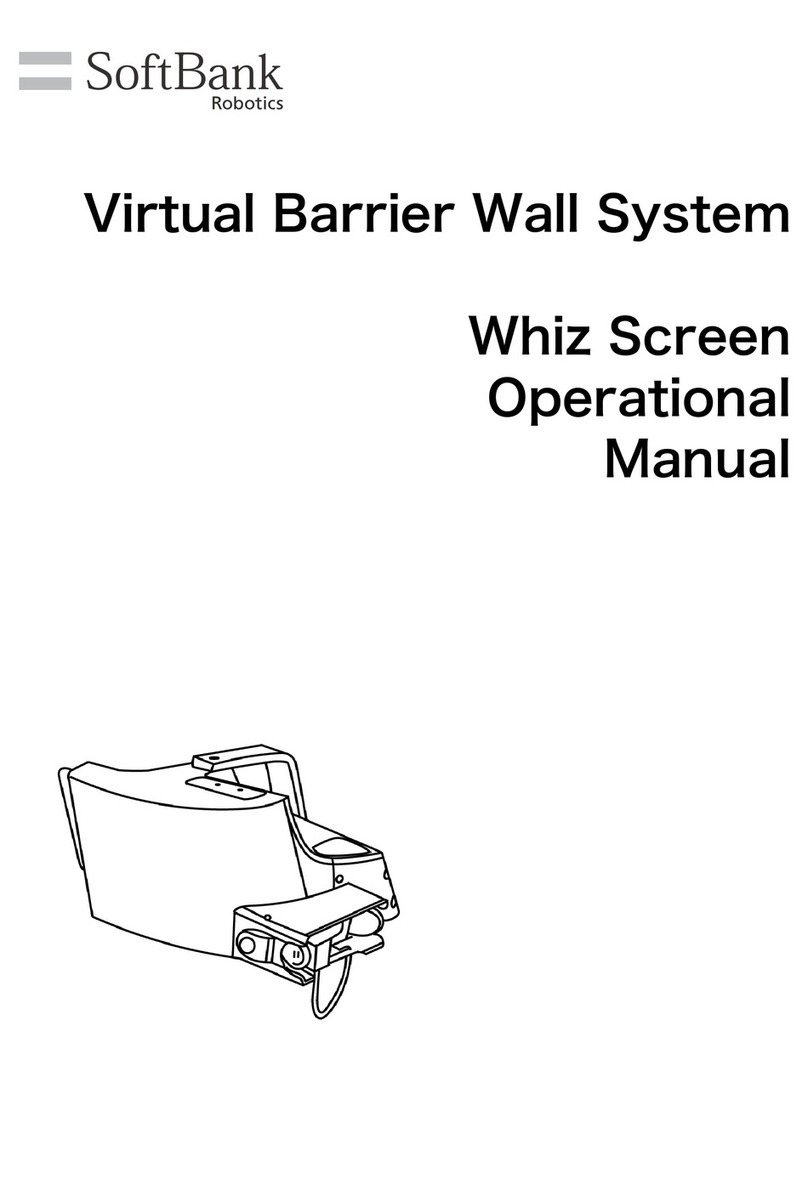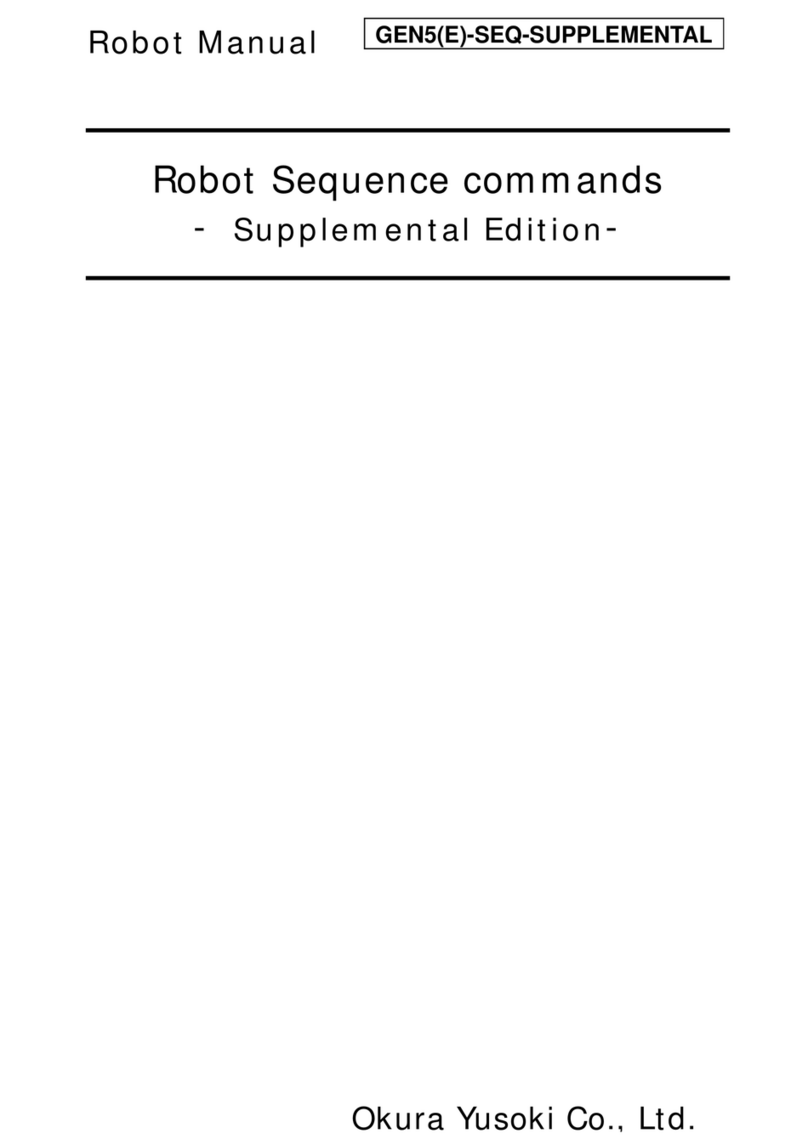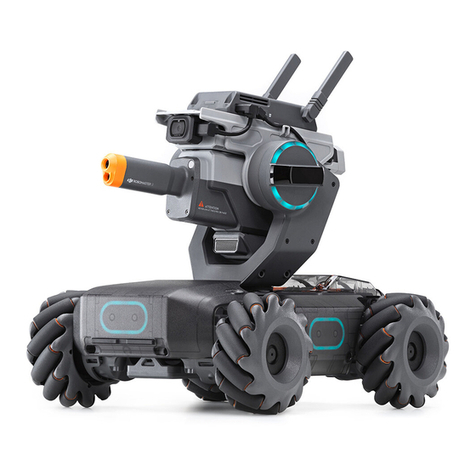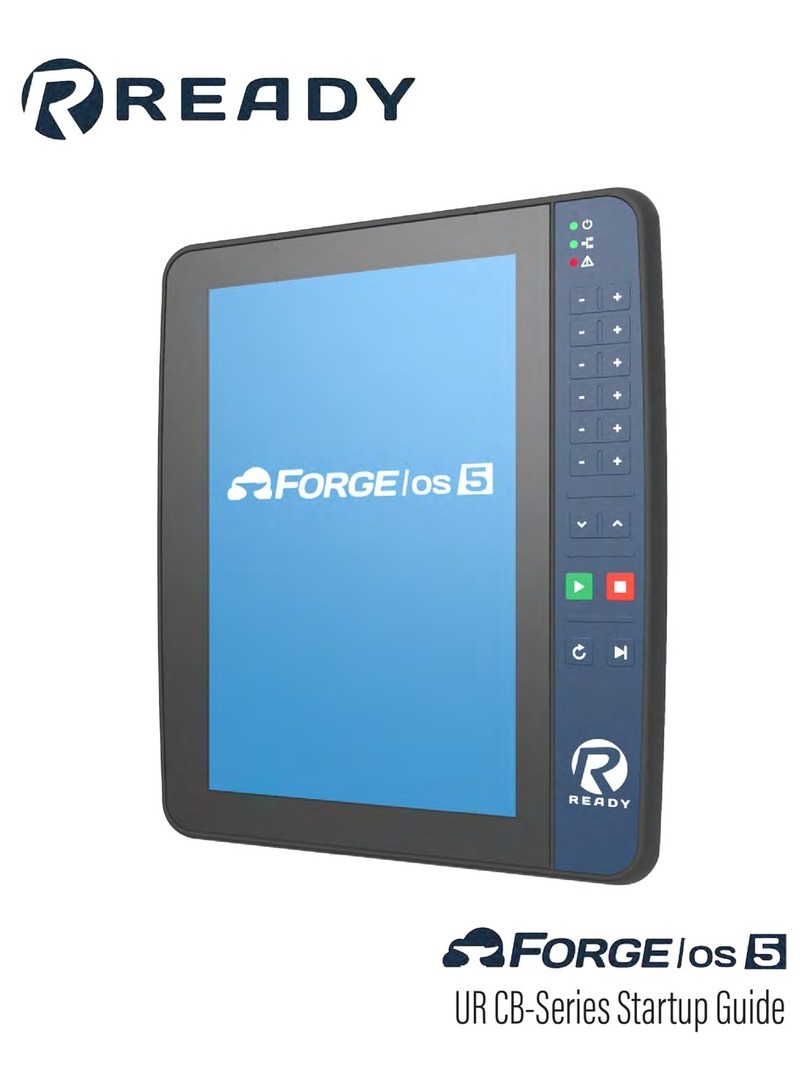RoboSense RS-LiDAR-16 User manual

RS-LiDAR-16 User Manual
1

RS-LiDAR-16 User Manual
2
Revision History
Revision
Content
Date
Edited by
1.0
Initial release
2017-03-01
RD
3.0
Fill in the content according to RS-LiDAR-16 1.0
hardware.
2017-05-10
RD
3.1
Modify the relationship between laser channel and
vertical angle
2017-06-13
PD
3.2
Update the content according to RS-LiDAR-16 2.0
hardware
Add the timestamp calculation method for every point
2017-07-17
PD
3.3
Improve the range to 150m
Delete the description that MAC addressing is the
same as serial number
Add azimuth interpolation calculation method
Corrected the data structure of UCWP
Add the instruction for RSVIEW
Add the instruction for ROS driver
2017-08-10
PD
3.4
Add the frame description for ROS driver
Add the RS-LiDAR information in RSVIEW
2017-08-23
PD
3.5
Correct the description for horizontal resolution
Add the description for LiDAR mechanical origin
2017-09-16
PD
3.6
Update the RS-LiDAR information and data port
setting
Update the protocol description of DIFOP
2017-12-05
PD
3.7
Correct the depth dimension of the mount hole
Add Phase Lock
Add fault diagnosis
Add operation status
2018-02-05
PD
3.8
Add trouble shooting
2018-03-15
PD
4.0
Add LiDAR flag for MSOP
Update DIFOP protocol
Add top and bottom board flag description
Add GPS input status flag
Add laser mechanical position
Add bottom board firmware online update
Add fault diagnosis usage
Add LiDAR installation suggestion
2018-06-25
PD

RS-LiDAR-16 User Manual
3
4.1
Add the sensor clean instruction
Add the RSVIEW compatible instruction
Add the LiDAR cable route instruction
2018-08-04
PD
4.2
Refine LiDAR power supply considerations
Add the instruction of space between the LiDAR and
mounting brackets
Modify the DIFOP data format
Add laser eye safety level instructions
Add aviation connector description and definition
Add Interface Box connection diagram
Update GPS synchronization protocol description
Add RS232 to TTL adapter wiring diagram and PIN
definition
Add return mode description
Add information to fault diagnosis
Modify the UCWP data format and add the FOV
setting description
Update Appendix C RSView content
Add the description of distance resolution 0.5cm
Add the description of intensity mode 3
2019-04-25
PD
V4.3
This version of the manual is applicable to radars of
V4.0 and later versions. For radars of previous
versions of V4.0, please refer to the manual of version
4.2.
Modify the definition and schematic diagram of the air
interface
Add the cleaning reminder in harsh environments
Adapted to the V4.0 version of the LiDAR, the number
of points per second is modified from 320000/s to
~300000/s
Adapted to the V4.0 version of the LiDAR, the
horizontal resolution of the point cloud is modified
from 0.09° -0.36° to 0.1° -0.4°
Change the working temperature to -30°C -60°C
Adapted to the V4.0 version of the LiDAR, at the
accurate point time calculation in Appendix A, the
transmission interval between the channels of the
device is changed from 3 μs to 2.8 μs, and the block
time is changed from 50 μs to 55.5 μs
Add description of replacing LiDAR configuration file
in Ubuntu system
2019-07-10
PD

RS-LiDAR-16 User Manual
4
Add GPS interface PIN definition of the V4.0 version
LiDAR’s interface box
4.3.1
Update electrical interface diagram
Add "LiDAR" to the network wiring definition
4.3.2
Correct some description faults
Add LiDAR mechanical installation suggestion
Update download address of RSView
Add LiDAR dimension diagram
Add footnote for specification in chapter 3
2019-12-11
PD
4.3.3
Replace the dimension drawing in Appendix E
Modify some descriptions
2020-02-18
PD

RS-LiDAR-16 User Manual
5
TABLE OF CONTENTS
1 Safety Notices........................................................................................................................................................ 9
2 Introduction...........................................................................................................................................................10
3 Product Specifications........................................................................................................................................ 11
3.1 Product Format.........................................................................................................................................11
3.2 Accuracy.................................................................................................................................................... 12
4 Connections......................................................................................................................................................... 13
4.1 Power......................................................................................................................................................... 13
4.2 Electrical Configuration...........................................................................................................................13
4.3 Interface Box Description....................................................................................................................... 14
4.4 Interface Box Connection....................................................................................................................... 16
5 Communications Protocols................................................................................................................................17
5.1 MSOP.........................................................................................................................................................18
5.1.1 Header............................................................................................................................................19
5.1.2 Data Field.......................................................................................................................................20
5.1.3 Tail................................................................................................................................................... 22
5.1.4 Demonstration Data..................................................................................................................... 22
5.2 DIFOP........................................................................................................................................................ 24
5.3 UCWP........................................................................................................................................................ 25
6 GPS Synchronization..........................................................................................................................................28
6.1 GPS Synchronization Theory.................................................................................................................28
6.2 GPS Usage............................................................................................................................................... 28
7 Key Features........................................................................................................................................................30
7.1 Return Mode............................................................................................................................................. 30
7.1.1 Return Mode Principle................................................................................................................. 30
7.1.2 The Strongest Return...................................................................................................................30

RS-LiDAR-16 User Manual
6
7.1.3 Strongest, Last and Dual Returns............................................................................................. 30
7.1.4 Return Mode Flag.........................................................................................................................30
7.2 Phase Lock............................................................................................................................................... 31
8 Point Cloud........................................................................................................................................................... 32
8.1 Coordinate Mapping................................................................................................................................ 32
8.2 Point Cloud Presentation........................................................................................................................32
9 Laser Channels and Vertical Angles................................................................................................................ 34
10 Calibrated Reflectivity.......................................................................................................................................36
11 Troubleshooting................................................................................................................................................. 38
Appendix A ▪ Point Time Calculate...................................................................................................................... 40
Appendix B ▪ Information Registers.....................................................................................................................41
B.1 Motor(MOT_SPD)....................................................................................................................................41
B.2 Ethernet(ETH).......................................................................................................................................... 41
B.3 FOV Setting (FOV SET).........................................................................................................................42
B.4 Motor Phase Offset (MOT_PHASE).....................................................................................................42
B.5 Top Board Firmware (TOP_FRM).........................................................................................................42
B.6 Bottom Board Firmware (BOT_FRM).................................................................................................. 43
B.7 Corrected Vertical Angle (COR_VERT_ANG).................................................................................... 43
B.8 Serial Number(SN)..................................................................................................................................44
B.9 Software Version(SOFTWARE_VER)..................................................................................................44
B.10 UTC Time(UTC_TIME).........................................................................................................................44
B.11 STATUS...................................................................................................................................................46
B.12 Fault Diagnosis......................................................................................................................................47
B.13 ASCII code in GPRMC Packet............................................................................................................48
Appendix C ▪ RSView............................................................................................................................................ 49
C.1 Features....................................................................................................................................................49
C.2 Install RSView..........................................................................................................................................49
C.3 Set up Network........................................................................................................................................ 49

RS-LiDAR-16 User Manual
7
C.4 Visualize Streaming Sensor Data.........................................................................................................50
C.5 Capture Streaming Sensor Data to PCAP File.................................................................................. 51
C.6 Replay Captured Sensor Data from PCAP File................................................................................. 52
C.7 RS-LiDAR-16 Factory Firmware Parameters Setting....................................................................... 54
C.8 RSView Data Port................................................................................................................................... 56
C.9 Firmware Online Update........................................................................................................................ 56
C.10 Fault Diagnosis......................................................................................................................................57
Appendix D ▪ RS-LiDAR-16 ROS Package........................................................................................................59
D.1 Prerequisite.............................................................................................................................................. 59
D.2 Install RS-LiDAR-16 ROS Package.....................................................................................................59
D.3 Configure PC IP address....................................................................................................................... 59
D.4 View the real time data...........................................................................................................................59
D.5 View the recorded pcap file offline....................................................................................................... 60
Appendix E ▪ Dimensions......................................................................................................................................62
Appendix F ▪ LiDAR Mechanical Installation Suggestion................................................................................ 63
Appendix G ▪ How to Distinguish the Port Number of MSOP and DIFOP Packets.................................... 64
Appendix H ▪ Sensor clean................................................................................................................................... 65
H.1 Attention.................................................................................................................................................... 65
H.2 Require Materials.................................................................................................................................... 65
H.3 Clean Method...........................................................................................................................................65

RS-LiDAR-16 User Manual
8
Terminologies
MSOP
Main Data Stream Output Protocol
DIFOP
Device Info Output Protocol
UCWP
User Configuration Write Protocol
Azimuth
Horizontal angle of each laser firing
Timestamp
The marker that records the system time
Header
The starting part of the protocol packet
Tail
The ending part of the protocol packet

RS-LiDAR-16 User Manual
9
Congratulations on your purchase of a RS-LiDAR-16 Real-Time 3D LiDAR Sensor. Please read
carefully before operating the product. Wish you a pleasurable product experience with RS-LiDAR-16.
1 Safety Notices
To reduce the risk of electric shock and to avoid violating the warranty, do not open sensor body.
Laser safety - The laser safety complies with IEC 60825-1:2014.
Read Instructions - All safety and operating instructions should be read before operating the
product.
Follow Instructions - All operating and use instructions should be followed.
Retain Instructions - The safety and operating instructions should be retained for future reference.
Heed Warnings - All warnings on the product and in the operating instructions should be adhered
to.
Servicing - The user should not attempt to service the product beyond what is described in the
operating instructions. All other servicing should be referred to RoboSense.

RS-LiDAR-16 User Manual
10
2 Introduction
RS-LiDAR-16, launched by RoboSense, is the first of its kind in China, world leading 16-beam miniature
LiDAR product. Its main applications are in autonomous driving, robot-environment perception and UAV
mapping.
RS-LiDAR-16, as a solid-state hybrid LiDAR, integrates 16 laser/detector pairs mounted in a compact
housing.
Unique features include:
Measurement range of up to 150 meters
Within 2 centimeters measurement accuracy
Data rate of up to 300,000 points/second
Horizontal Field of View (FOV) of 360°
Vertical Field of View (FOV) of 30° (-15°~+15°)
The compact housing of RS-LiDAR-16 mounted with 16 laser/detector pairs rapidly spins and sends out
high-frequency laser beams to continuously scan the surrounding environment. Advanced digital signal
processing and ranging algorithms calculate point cloud data and reflectivity of objects to enable the
machine to “see” the world and to provide reliable data for localization, navigation and obstacle
avoidance.
Figure 1: RS-LiDAR Imaging System.
Operation of device include:
Establish communication with RS-LiDAR-16;
Parse the data packets for azimuth, measured distance, and reported calibrated reflectivity;
Calculate X, Y, Z coordinates from reported azimuth, measured distance, and vertical angle;
Store the data as needed;
Read current device configuration data;
Set Ethernet, time and rotational speed as needed.

RS-LiDAR-16 User Manual
11
3 Product Specifications1
3.1 Product Format
Table 1: Product Parameters.
1The following data is only for mass-produced products. Any samples, testing machines and other non-mass-produced versions
may not be referred to this specification. If you have any questions, please contact RoboSense sales.
2The measurement target of rang is a 20% NIST Diffuse Reflectance Calibration Targets, the test performance is depending on
circumstance factors, not only temperature, range and reflectivity but also including other uncontrollable factors.
Sensor
Time of Flight Distance Measurement
16 Channels
Measurement Range: 40cm to 150m (on 20% reflectivity target)2
Accuracy: ±2cm (typical, refer to Figure 2)3
Field of View (Vertical): ±15.0° (30° in total)
Angular Resolution (Vertical): 2°
Field of View (Horizontal): 360°
Angular Resolution (Horizontal/Azimuth): 0.1°(5Hz) to 0.4°(20Hz)
Rotation Rate: 300/600/1200 rpm(5/10/20 Hz)
Laser
Class 1
Wavelength: 905nm
Full Beam Divergence Horizontal: 7.4 mrad, Vertical: 1.4 mrad
Output
Data Rate: ~300,000 points/second
100Mbps Ethernet
UDP packet, include:
Distance
Rotation Angle/Azimuth
Calibrated Reflectivity
Synchronized Timestamp (Resolution: 1us)

RS-LiDAR-16 User Manual
12
3.2 Accuracy
Figure 2: The Relation between accuracy and distance of target object.
3The measurement target of accuracy is a 50% NIST Diffuse Reflectance Calibration Targets, the test performance is depending on
circumstance factors, not only temperature, range and reflectivity but also including other uncontrollable factors.
4The test performance of power consumption is depending on circumstance factors, not only temperature, range and reflectivity but
also including other uncontrollable factors.
5Device operating temperature is depending on circumstance, including but not limited to ambient lighting, air flow and pressure
etc.
Mechanical/
Electrical/
Operational
Power Consumption:12 W (typical)4
Operating Voltage: 9-32 VDC (with Interface Box and Regulated
Power Supply)
Weight: 0.87 Kg (without cable)
Dimensions: 109 mm Diameter X 80.7 mm Height
Environmental Protection: IP67
Operation Temperature: -30 ℃to +60 ℃5
Storage Temperature: -40 ℃to +85 ℃

RS-LiDAR-16 User Manual
13
4 Connections
4.1 Power
When equipped with an interface box, the device requires a voltage range of 9-32 VDC, and 12 VDC is
recommended.
If the interface box is not used for the LiDAR, a regulated 12 VDC must be used, while the V4.0 and
later versions of the LiDAR integrate the wide-voltage function internally, so you can continue to use
9-32 VDC.
The power consumption of the device is about 12 W (typical).
4.2 Electrical Configuration
RS-LiDAR-16 comes with an integral cable(power/data) that is permanently attached to the sensor and
terminates at a standard SH1.25 wiring terminal. Figure 3 illustrates the serial PINs and their properties.
To operate RS-LiDAR-16, the user should insert the SH1.25 wiring terminal to the corresponding port on
the Interface BOX.
Figure 3: Wiring Terminal and Serialized PIN.
The RS-LiDAR-16 has a type that uses the aviation connector. The cable length between the LiDAR and
the aviation connector is 1 meter. The specific PINs of the aviation connector are defined as follows:

RS-LiDAR-16 User Manual
14
Figure 4: Aviation Plug PIN Number.
4.3 Interface Box Description
The Interface BOX is connected to the RS-LiDAR-16 by default.
The Interface BOX provides indicator LEDs for power, interfaces for power, 100Mbps Ethernet, and
GPS inputs. The DC 5.5-2.1 connector for power input, RJ45 Ethernet connector for RS-LiDAR-16 data
output and SH1.0-6P female connector for GPS input.
Note: The default cable of the interface box is 3 meters long, if you have other length requirements please
contact the RoboSense technical support. Because of the different LiDAR versions, there are two definitions
and different levels of the GPS port on the interface box.
The corresponding positions of the interface are as follows (As shown in Figure 5):
PIN
Wire Color
Function
1
Red
+12V
2
Yellow
+12V
3
White
GROUND
4
Black
GROUND
5
Green
GPS PULSE
6
Blue
GPS REC
7
Brown
LiDAR Ethernet RX-
8
Brown white
LiDAR Ethernet RX+
9
Orange
LiDAR Ethernet TX-
10
Orange white
LiDAR Ethernet TX+

RS-LiDAR-16 User Manual
15
PIN No.
V4.0 and later versions
Other versions
1
GPS PULSE
GPS REC
2
+5V
GPS PULSE
3
GND
GND
4
GPS REC
NC
5
GND
NC
6
NC
+5V
Figure 5: Interface definition on Interface Box.
Note: When RS-LiDAR-16 connects its grounding system with an external system, the external power
supply system should share the same grounding system with that of the GPS.
On the Interface BOX, the red light indicator means standard power input, and the green one means
standard power output. The Interface BOX access protection status when the red light indicator lights up
and green light indicator blacks out. If the red and green light indicators blink at the same time, please
check for errors of the power supply. If the power supply is checked without error, the high chance is that
the Interface BOX is damaged. Please return damaged Interface BOX to RoboSense for service.
GPS interface definition: GPS REC means GPS UART input, GPS PULSE means GPS PPS input.
Ethernet interface complies with EIA/TIA568 Standard.
Power interface adopts standard DC 5.5-2.1 connector.

RS-LiDAR-16 User Manual
16
4.4 Interface Box Connection
Figure 6: Interface Box connection diagram.

RS-LiDAR-16 User Manual
17
5 Communications Protocols
RS-LiDAR-16 adopts UDP protocol and communicates with computer through 100Mbps Ethernet.
There two different kinds of UDP output packets: MSOP packets and DIFOP packets. The UDP protocol
packet in this manual is of 1290 byte long, and consists of a 1248-bytes- payload and a 42-byte header.
The IP address and port number of RS-LiDAR-16 is set in the factory as shown in the Table 2, but can
be changed by the user as needed.
Table 2: The IP Address and Port Number Set at the Factory.
The default MAC Address of each RS-LiDAR-16 is set in the factory. The MAC Address can be changed
as needed.
To establish communication between a sensor and a computer, the IP address of the computer should
be set at the same network segment of that of the sensor. By default: 192.168.1.X (X can be taken by a
value from 1~254), subnet mask: 255.255.255.0. In case of uncertainty about the internet setting of the
sensor, please connect the sensor to the computer, and parse packet to get the IP and port through
Wireshark.
RS-LiDAR-16 adopts 3 kinds of communications protocols to establish communication with the
computer:
MSOP (Main Data Stream Output Protocol). Distance, azimuth and reflectivity data
collected by the sensor are packed and output to computer.
DIFOP (Device Information Output Protocol). Monitor the current configuration information
of the sensor.
UCWP (User Configuration Write Protocol). User can modify some parameters of the
sensor as needed.
Table 3: Protocols Adopted by RS-LiDAR-16.
Note
:
The following section describes and defines the valid payload (1248 byte) of the UDP protocol packet.
IP Address
MSOP Port No.
DIFOP Port No.
RS-LiDAR-16
192.168.1.200
6699
7788
Computer
192.168.1.102
Protocol
Abbreviation
Function
Type
Size
Interval
Main Data Stream Output Protocol
MSOP
Scan Data Output
UDP
1248byte
~1.33 ms
Device Information Output Protocol
DIFOP
Device Information Output
UDP
1248byte
~100 ms
User Configuration Write Protocol
UCWP
Sensor Parameters Setting
UDP
1248byte
INF

RS-LiDAR-16 User Manual
18
5.1 MSOP
I/O type: device output data, computer parse data.
Default port number is 6699.
MSOP outputs data information of the 3D environment in packets. Each MSOP packet is 1248 bytes
long and consists of reported distance, calibrated reflectivity values, azimuth values and a time stamp.
Each RS-LiDAR-16 MSOP packet payload is 1248 byte long and consists of a 42-byte header and a
1200-byte data field containing twelve blocks of 100-byte data records and a 6-byte tail.
The basic data structure of a MSOP packet for single return is as shown in Figure 7.
Figure 7: Single Return MSOP Packet.
channel data 16
channel data 16
channel data 16
channel data 32
channel data ...
channel data 17
channel data 17
channel data ...
channel data 32
channel data 17
channel data ...
channel data 32
42 bytes
data packet
12 * 100 bytes = 1200 bytes
MSOP Packet (1248 bytes)
6 bytes
42 bytes
(21st~30th
byte is
time
stamp)
Header
Tail
4 bytes
resv. + 2
bytes
(0x00,
0xFF)
channel data 1
channel data 2
0xffee
Data block 1
Azimuth 1
channel data ...
channel data 16
channel data 1
channel data 2
0xffee
Data block 2
Azimuth 2
channel data ...
channel data 1
channel data 2
0xffee
Data block n
Azimuth n
channel data ...
channel data 1
channel data 2
0xffee
Data block 12
Azimuth 12
channel data ...
channel data 17
channel data ...
channel data 32

RS-LiDAR-16 User Manual
19
The basic data structure of a MSOP packet for dual return is as shown in Figure 8.
Figure 8: Dual Return MSOP Packet Definition Diagram.
5.1.1 Header
The 42-byte header marks the beginning of data blocks. In the 42-byte data header, the first 8 bytes are
for header identification, the 21st. to 30th. byte records time stamp, the 31st byte represents the LiDAR
model, and the rest bytes are reserved for future updates.
The first 8 bytes of the header is defined as 0x55,0xAA,0x05,0x0A,0x5A,0xA5,0x50,0xA0.
Time stamp with a resolution of 1 μs records the system time. Please refer to the definition of time in
Appendix B.10 and Table 8 in part 3 of this section. The 31st byte LiDAR model is described as below:
Table 4: LiDAR Model Flag.
LiDAR Model (1 byte)
0x01
RS-LiDAR-16
0x02
RS-LiDAR-32
channel data 16
channel data 16
channel data 16
Second
Return
First
Return
channel data 32
channel data ...
channel data 17
channel data 17
channel data ...
channel data 32
channel data 17
channel data ...
channel data 32
42 bytes
data packet
12 * 100 bytes = 1200 bytes
MSOP Packet (1248 bytes)
6 bytes
42 bytes
(21st~30th
byte is
time
stamp)
Header
Tail
4 bytes
resv. + 2
bytes
(0x00,
0xFF)
channel data 1
channel data 2
0xffee
Data block 1
Azimuth 1
channel data ...
channel data 16
channel data 1
channel data 2
0xffee
Data block 2
Azimuth 2
channel data ...
channel data 1
channel data 2
0xffee
Data block n
Azimuth n
channel data ...
channel data 1
channel data 2
0xffee
Data block 12
Azimuth 12
channel data ...
channel data 17
channel data ...
channel data 32

RS-LiDAR-16 User Manual
20
5.1.2 Data Field
Data field comprises data blocks that contain valid measurement data. Each data filed contains 12
blocks. Each block is 100-byte long and is a complete measurement data set. Each data block begins
with a 2-byte start identifier “0xffee”, then a two-byte azimuth value (rotational angle). Each azimuth
value records 32 sets of channel data reported by the 16 laser channels for two sequence. (Please see
chapter 9 for the relationship between channel sequence and vertical angel.)
5.1.2.1 Azimuth Value
The reported azimuth is associated with the first laser firing in each sequence of 16 laser firings. The
Azimuth Value is recorded by the encoder. The zero position on the encoder indicates the zero degree
of azimuth value on RS-LiDAR-16. In one data block, there are 32 sets of laser data indicating two
sequence of the 16 laser firings, however only every-other encoder angle is reported for alternate firing
sequences. So under single return mode user can choose to interpolate that unreported encoder stamp
(Refer to 5.1.2.2). The resolution of Azimuth is 0.01°.
For example, in Figure 10, the azimuth value is calculated through the following steps:
Get azimuth values: 0x00
,
0x44
Combine to a 16 bit, unsigned integer: 0x0044
Convert to decimal: 68
Divided by 100
Result: 0.68°
Hence the firing angle is 0.68°
Note: the position of 0° on sensor is the Y axis positive direction in Figure 14.
5.1.2.2 Azimuth Value Interpolation
Because the RS-LIDAR-16 reports the azimuth value for every-other firing sequence, it’s helpful to
interpolate the un-reported azimuth when the LiDAR works under single return. There are several ways
to interpolate the un-reported azimuth, but the one given below is simple and straight forward.
Consider a single data packet. The time between the first firing of the first sequence of sixteen firings
(Data Block 1) and the first firing of the third sequence of sixteen laser firings (Data Block 2) is
~100.0 µs. If you assume the rotation speed over that short interval is constant, you can assume the
azimuth of the (N+1) set of sixteen laser firings is halfway between the azimuth reported with the Nth set
of 16 laser firings and the azimuth reported with the (N+2) set of laser firings.
Below is pseudo-code that performs the interpolation. The code checks to see if the azimuth rolled over
from 359.99° to 0° between firing sequence N and N+2.
Other manuals for RS-LiDAR-16
1
This manual suits for next models
1
Table of contents
Other RoboSense Robotics manuals
Popular Robotics manuals by other brands

DAGU
DAGU Playful Puppy instruction manual
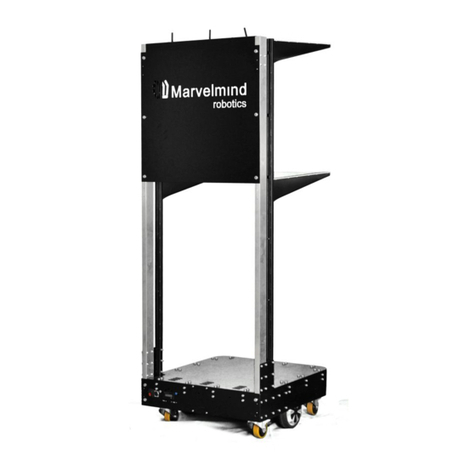
Marvelmind
Marvelmind Autonomous Delivery Robot operating manual
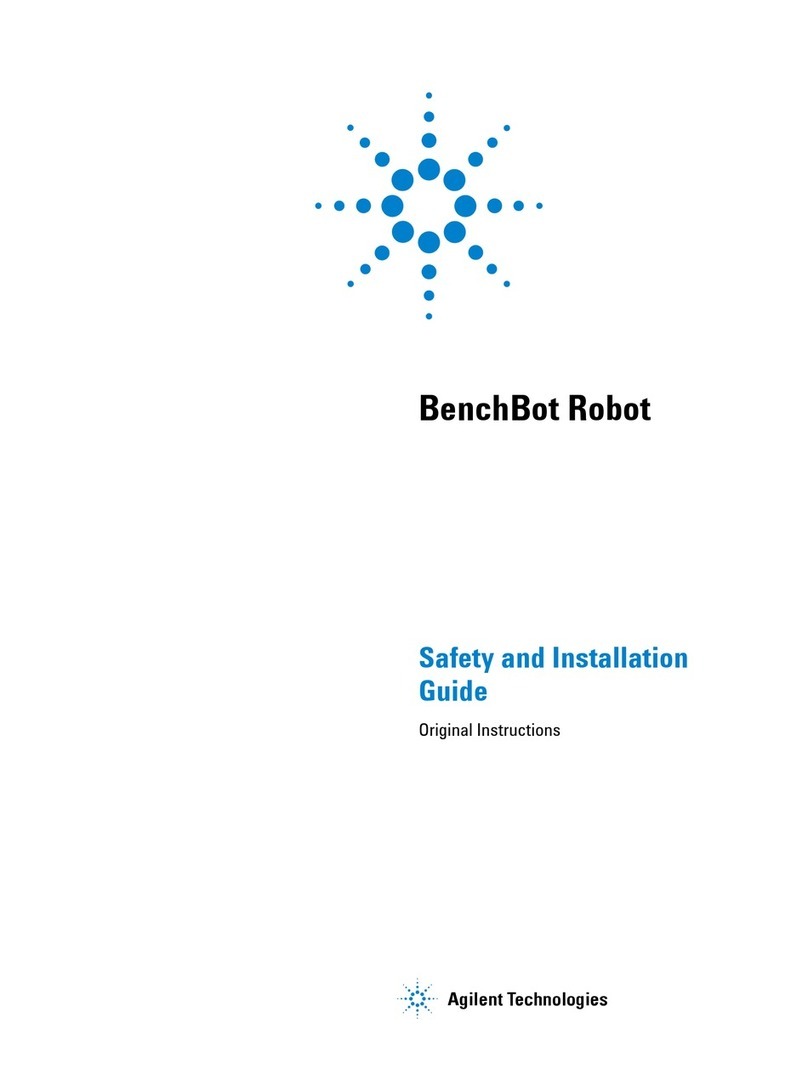
Agilent Technologies
Agilent Technologies BenchBot Safety and installation guide
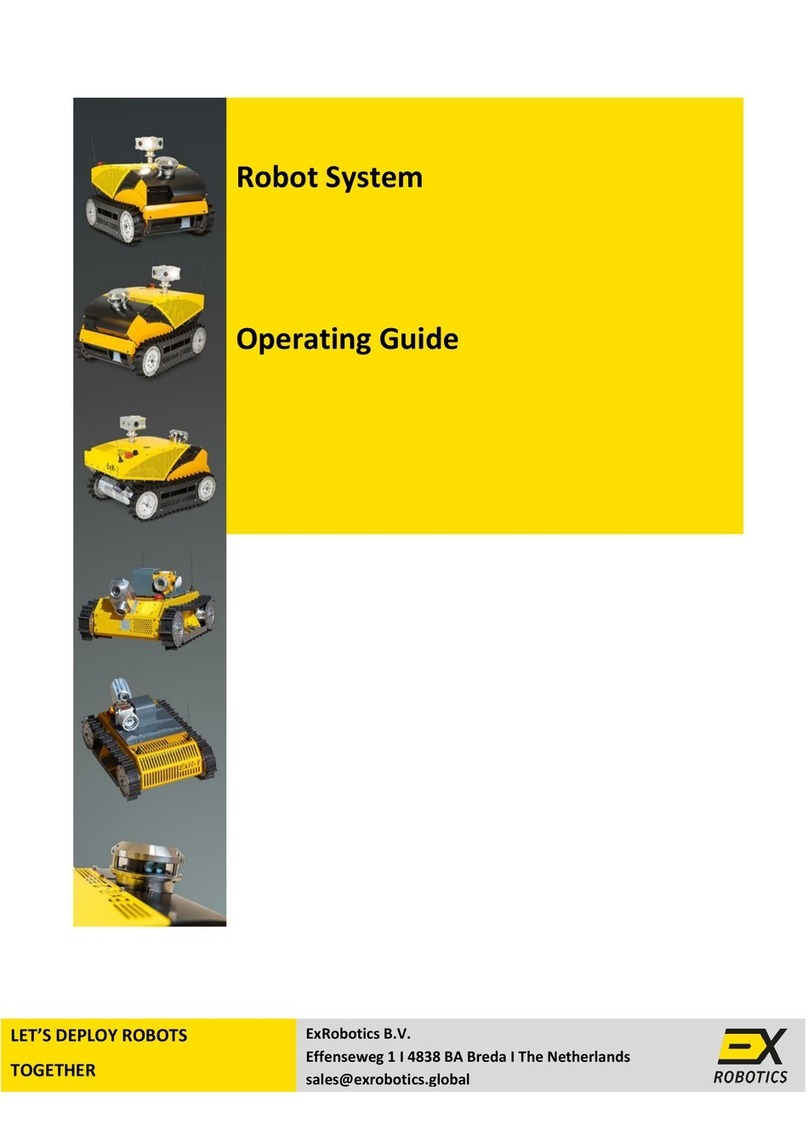
ExRobotics
ExRobotics ExR-1 operating guide

Rasson
Rasson S154A Assembly instructions
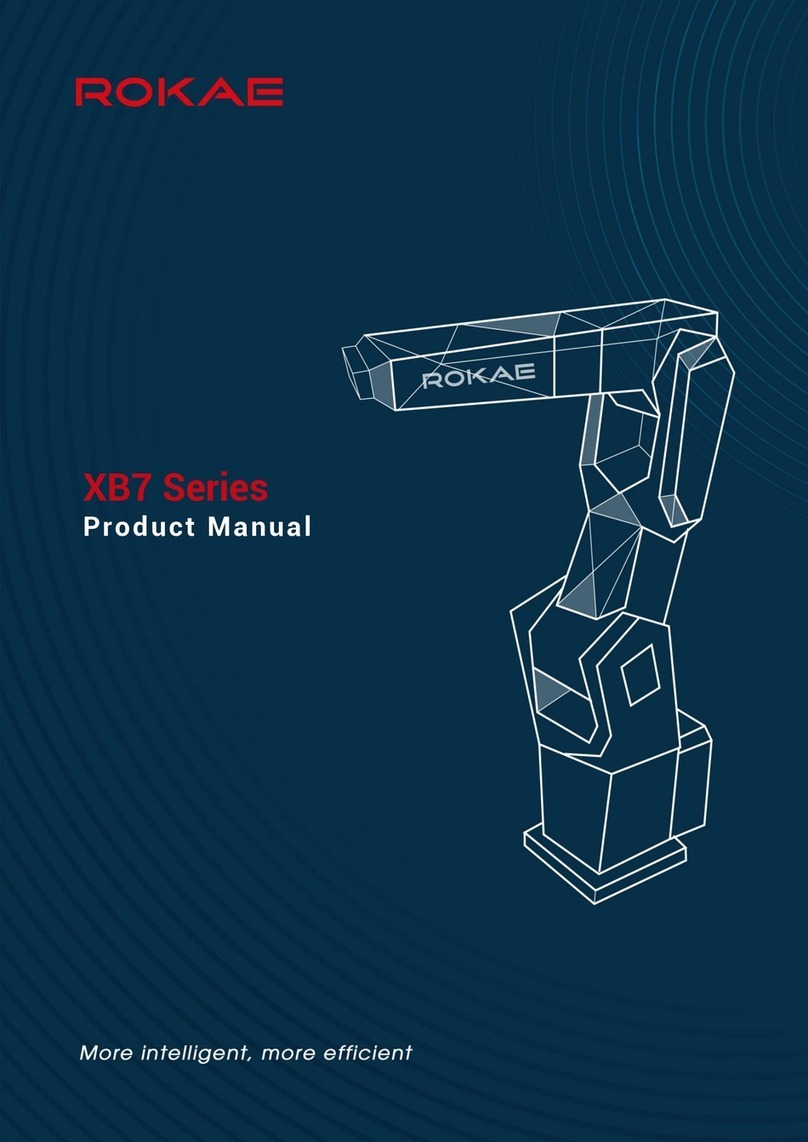
ROKAE
ROKAE XB7 Series product manual
